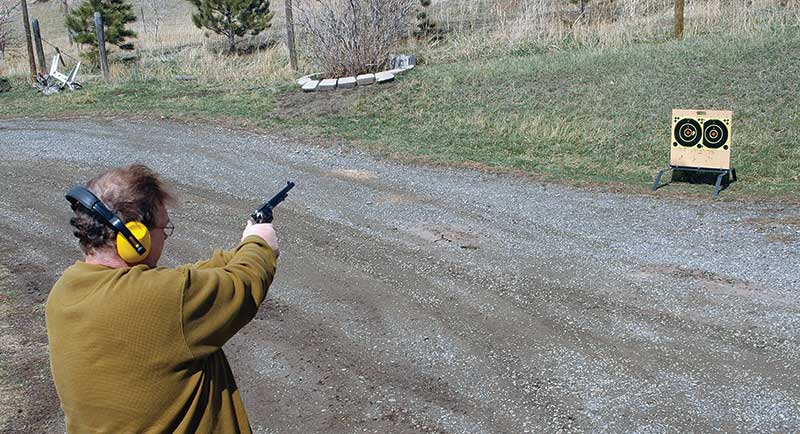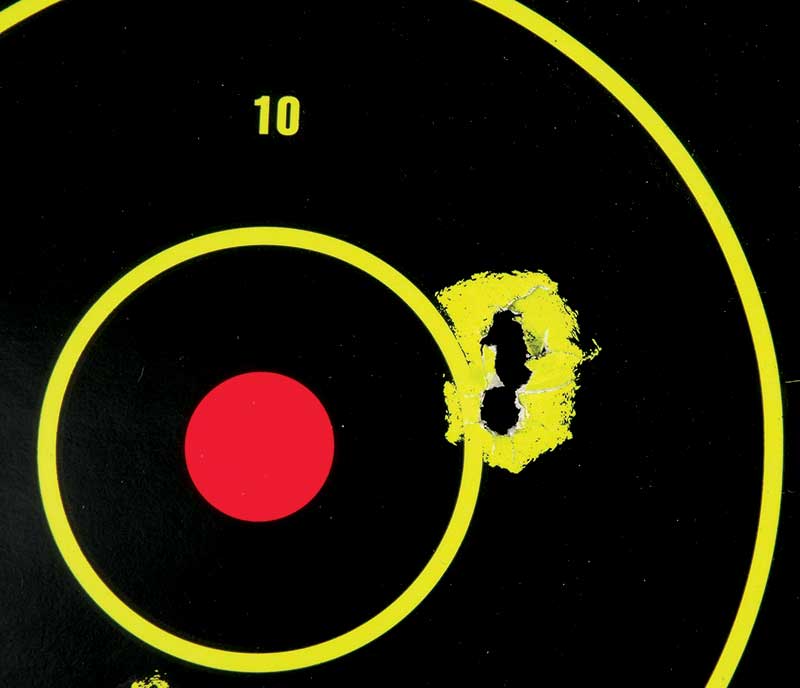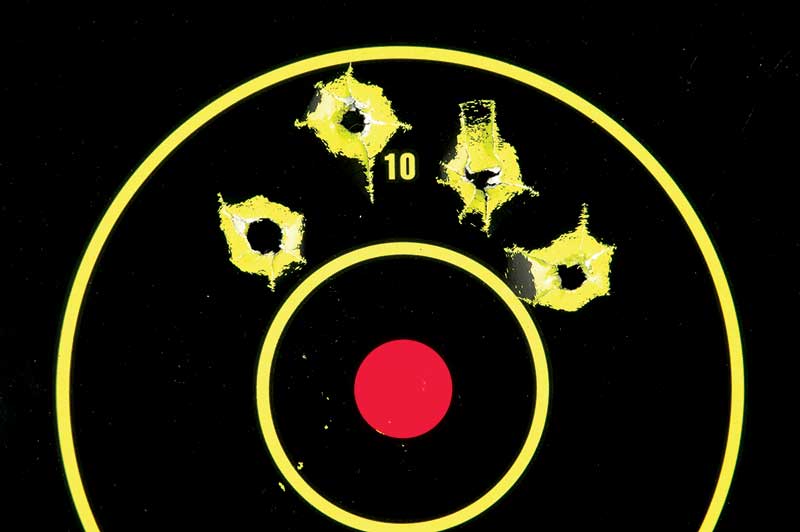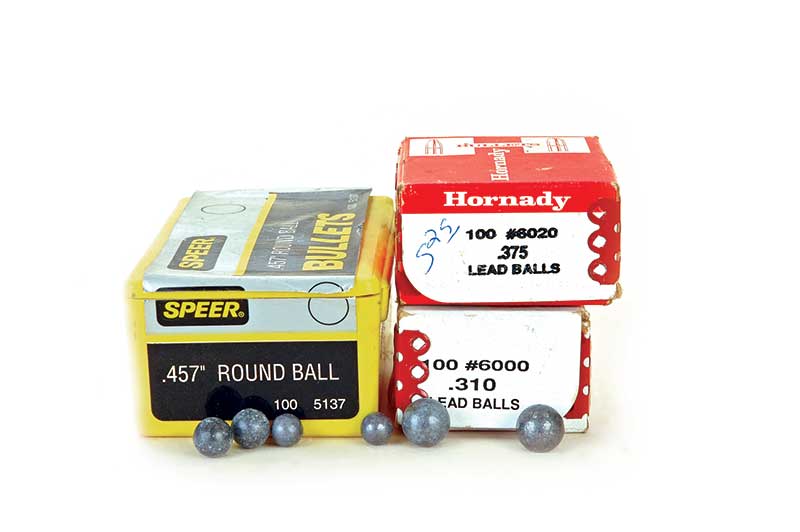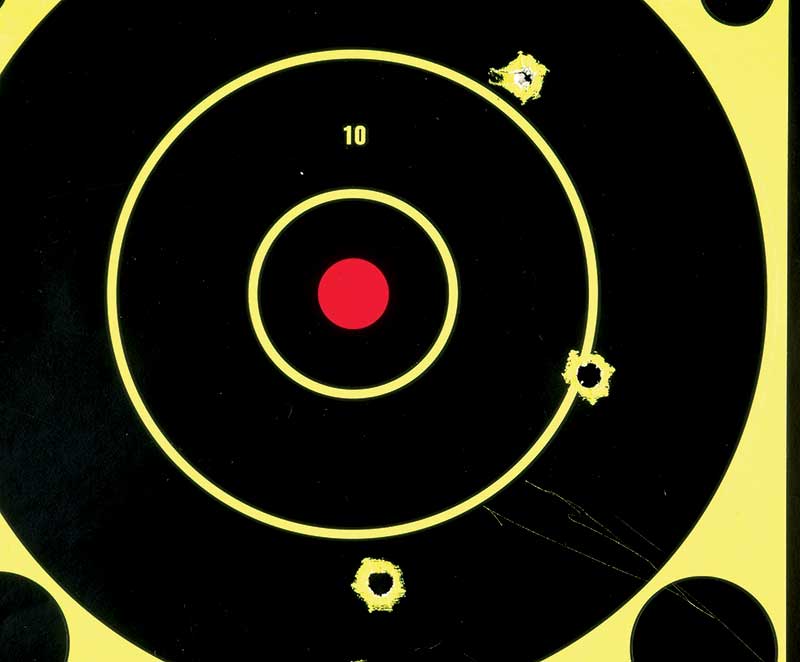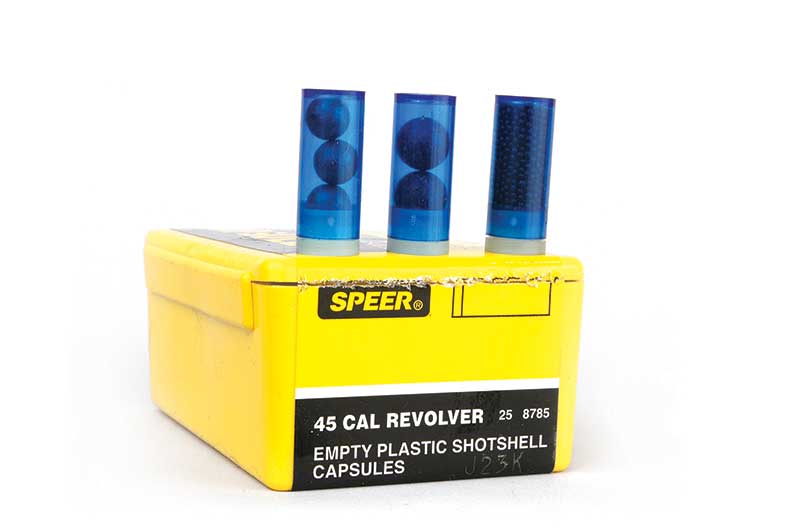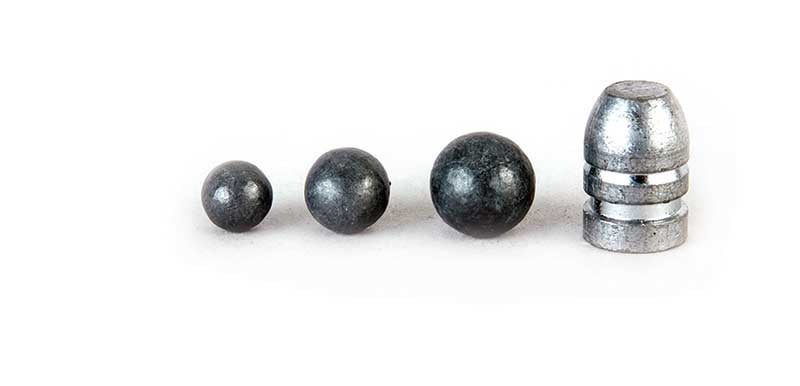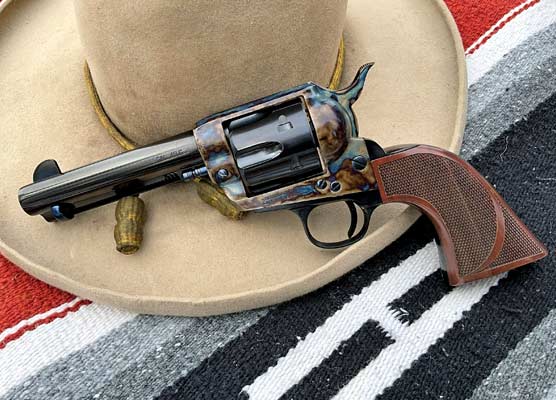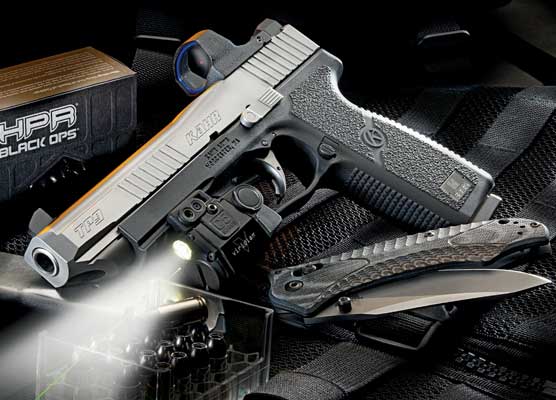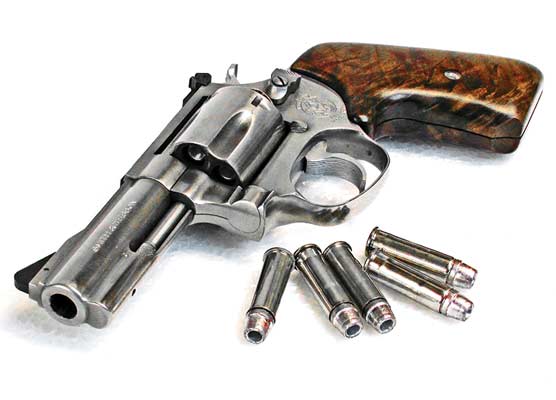Buck and Ball For .45 Colt Handguns
Two or three holes with one shot!
I’ve previously made it clear I am not the .45 Colt’s greatest fan. That said, there is one area where it shines above all other revolver cartridges. That is for “novelty” handloading such as shot loads or my newest brainstorm, “buck & ball” cartridges.
That old term stems from smoothbore musket times when military paper cartridges often held three buckshot with one large round ball. The idea was the more projectiles put into the air with each shot the more likelihood one might connect with an enemy soldier. So far, I haven’t figured out how to get three buckshot in a revolver cartridge along with a ball but I do have loads with three buckshot, or one buckshot and a ball, or two balls. They’re easy to make, although it helps to have a variety of reloading dies on your bench. They’re perfectly safe to shoot if you use common sense in their preparation.

As Duke says, it helps to have a reloading bench with a good variety of equipment.
To seat the first .45 caliber round ball deep in the case, Duke used the expander
plug from a set of .40-65 dies (left). Then to seat the second ball, Duke used the
expander plug from a regular set of .45 Colt dies (right).
Two Balls?
Let’s start first with double-ball loads. It may surprise some handgun shooters that ordinary round lead balls as sold for muzzleloaders can make fine revolver projectiles. And I figure them the same as I do donuts — if one is good then two is better. For .45 Colt they come ready made in sizes of .451″, .454″ and .457″. Being pure lead all of those are usable for .45 Colt.
Here is one factor absolutely necessary, whether you’re loading one round ball or two, they must be lubricated. Firing raw lead down a revolver barrel will foul it terribly. Again the solution is simple. Just buy a tube of Lee’s Liquid Alox bullet lubricant. To apply, put a squirt of it in an empty plastic bullet box; dump in several dozen of your chosen pure lead round balls, and shake for a few seconds. When the box is opened every one of those lead projectiles will be covered with liquid Alox. It will soon dry and provide more than enough lubrication.
Here’s how I load two-round balls in a .45 Colt cartridge case. First off, weigh the balls because their combined weight will be beyond the weight of a single bullet. I had some .457″ Speer balls on hand. They weighed 145 grains each. Some home cast .454″ ones weighed 142 grains each. Lyman’s newest manual says maximum .45 Colt load for a 255 grain bullet is 8.5 grains of Unique. So I reduced powder charge to 6.0 grains of Unique for two balls weighing 284 to 290 grains.
Once the powder charge is in the case, I eyeball its level carefully and then using the case mouth expanding plug from smaller caliber reloading die set I push the first round ball close to the powder but not on it or compressing it. For .45 Colt, I seat the first round ball with a .40-65 case mouth-expanding plug but most any size smaller than .45 will work. Here’s a tip: Flare the case mouth a bit excessively so as to not scrape lubricant from the round ball as it’s going in. Next I press the second round ball on top of the first, this time using the regular .45 Colt case mouth expander plug. It should seat deep enough so the coming crimp will roll over its curve. The accompanying photo shows that better than words will describe it.
All this is a bit extra effort at the reloading bench and as said it helps to have a good variety of equipment. You’re certainly not going to get it done just by pumping the handle of a progressive press. Once you have the hang of it and get a sort of assembly line going it’s not to difficult to put together 50 or 100 double-ball loads in an hour or so. The reward is the look on your shooting buddies’ faces when you pull the trigger once and two bullet holes appear like magic in the target. It’s a double tap with one pull of the trigger. Here’s an odd thing I have noticed about double ball loads. Some handguns print the two balls laterally. Others print them vertically. Of course in both instances their points of impact diverge more as range increases. At 50′ with my 7½”-barreled Colt SAA the two balls impact about 1½” from each other.
Less Work
Now to contradict myself, here’s a way to avoid lubing balls and the shenanigans that go with seating two round balls in cartridge cases. The keys are the plastic capsules sold for loading your own revolver shot loads. For many years Speer only made them for .38/.357 and .44 but now also have them for .45 Colt.
In the .45 Colt capsules you can get three .310″ round balls or two .375 caliber ones or one of each size. I could almost get two .310″ round balls and one .375″ one in the .45 Colt capsule but the bottom cap was just a hair from snapping in place completely. At this point we can pretty much forget two things. One is lubrication, because the revolver’s barrel is protected from lead smears by the walls of the plastic capsule.
The other is fretting over whether or not you have reduced powder charge sufficiently. There’s no way you can get enough weight in the form of round lead balls in the shot capsules to weigh as much as a standard .45 Colt bullet. For instance, three of the .310″ balls weigh a mere 135 grains (excluding the capsule’s weight) and two .375″ balls only weigh 160 grains (excluding capsule’s weight). So I raised the Unique powder charge to 7.0 grains with both sets of round balls.
Now here are a couple of interesting points. At first with two 80-grain .375″ round balls rattling loose in the .45 Colt shot capsule, recoil of a preceding round caused remaining ones to break through and fall out the front of the revolver’s cylinder. Being the bright light I am, I then placed a felt .36-caliber Ox-Yoke Wonder Wad in the front of the shot capsule. The problem disappeared. That felt wad cushioned the round balls enough so that after five full power .45 Colt loads were fired first, the capsules held together.
Here is a second interesting point. Three .310″ balls dispersed far more widely than two .375″ ones. From my Colt SAA’s 7½” barrel .45 Colt, the three balls were 7″ to 8″ apart. With two .375″ round balls points of impact were about 3″ or so apart. As a grand finale to this project I envisioned loading up six of the three buckshot/.45 Colt loads and in fast firing put 18 holes in a target. It would make an impressive photograph. But alas, I was having so much fun playing with this “buck & ball” concept that not enough .45 Colt shot capsules were left at the end.
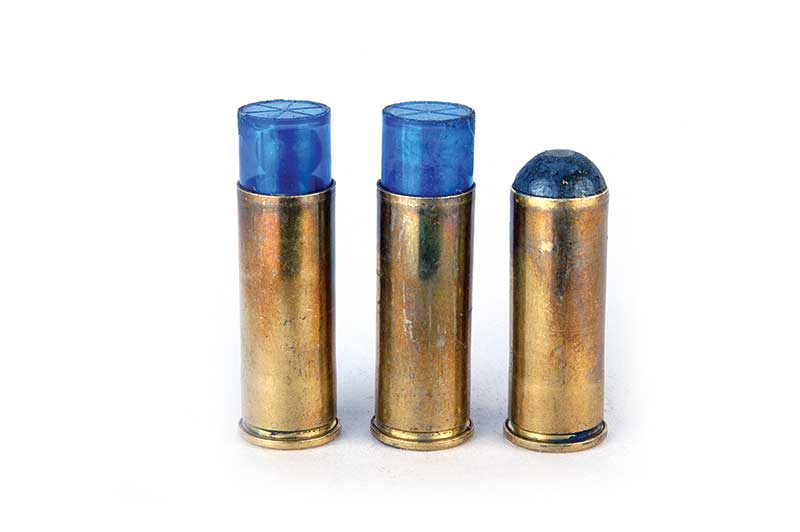
These cartridges are examples of Duke’s buck & ball .45 Colt handloads.
At left is round with three .31 caliber buckshot in a Speer plastic capsule.
Middle shows .45 Colt round with two .375” round balls in a Speer plastic
capsule. Front of capsule has a felt wad to buffer it so the balls don’t break
it during recoil. Round at right is .45 Colt loaded with two .457" round balls.
Power Questions
In the past I’ve written about using .45 caliber gas checks as over powder and over shot wads in .45 Colt cases in making shot loads for rattlesnake control around my home. Once Speer brought out the .45 Colt plastic shot capsules that made the gas check method obsolete. Still considering myself a “bright light” gas checks were tried in .45 Colt cases in an effort to get more buckshot inside. My lights got dimmed dramatically with that method. There isn’t enough resistance offered by the gas checks and loose buckshot to make smokeless powder burn well. Those loads went off with a sort of “poo” sound and the buckshot bounced off a piece of 1/8″ plywood. Bad idea, that one.
How powerful are the double ball loads and the buck and ball ones in plastic shot capsules? Here’s what my chronograph told me. Two .457″ round balls powered by 6.0 grains of Unique gave 807 fps. Two .375″ round balls held by a plastic capsule chronographed 855 fps. Three .310″ round balls, again inside a plastic capsule clocked at 939 fps.
In a future issue I’ll tell you how to make them for several other revolver calibers for which ready-made pure lead round balls are not readily available. But at this point I must confess one thing: for the life of me I can’t figure out a really practical use for “buck & ball” handgun loads. I don’t give advice about home and self-defense guns or ammunition so I’m not recommending them for those purposes. Perhaps a Montana winter just leaves me too much time sitting in front of a well stocked reloading bench and my natural tinkering urges begin to take over. It matters not. Playing with the “buck & ball” concept for revolvers was a lot of fun.

